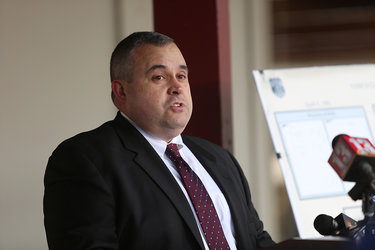‘There is always hope’ says Commander Hornick after identifying man who died in 1981
BETHLEHEM — The large brown accordion folder that Commander Adam Hornick has been filling for nearly a decade is labeled “John Doe” in black capital letters.
John Doe now has a name: Franklin D. Feldman.
Feldman died in Bethlehem in 1981. His body was found several months after his death at Vadney Farm when, on April 3 of that year, a landowner repairing a fence damaged over the winter came across the remains.
The body was never identified — until now.
On Thursday, Hornick spoke at a press conference, standing on property adjacent to the Vadney Farm, to tell the story of how the 42-year-old mystery was solved.
“This is the first case in Albany County and Capital Region history to use investigative genetic genealogy,” said Hornick.
The method, he said, is “often extremely costly.”
Hornick last talked to The Enterprise about the cold case in 2019 when a push was made to publicize it in hopes of finding relatives or people who knew Feldman.
Hornick was just 5 years old in the spring of 1981 when Feldman’s body was found in the woods on the edge of the back of the Elm Avenue Town Park. When Hornick became a detective sergeant in 2013, one of his duties was to verify files in the department’s database.
He was given just two sheets of paper, typewritten, on the unidentified dead man. “We couldn’t find the case file,” Hornick said. And no one currently working for the Bethlehem Police remembered it. “I started to rebuild it.”
Cold cases have always fascinated Hornick. Many in the Bethlehem department helped Hornick and so did agencies across the state and nation as Hornick rebuilt the case file.
The granddaughter of the man who had discovered the body in the midst of fence repair was interviewed. So were the officers still alive who had worked on the case back in 1981. Bethlehem Police revisited the scene where the body had been discovered. They also looked at open missing-person cases but found no match.
“Chances diminish as time goes on,” Hornick said then.
A big break came because the original two typewritten sheets described the dead man’s jaw bones. “We didn’t have them,” Hornick said.
Consulting the records he had obtained, Hornick learned the jaw bones had been sent to a dentist named Alan Rosell in Ballston Spa. Rosell had retired to Arizona, Hornick said, but he talked to a woman who had worked with Rosell and she checked through boxes in the dentist office’s basement.
She read out numbers and one of them matched the coroner’s case number that Hornick had obtained.
He recovered the box with the jaw bones in June 2017 and then he worked with a forensic odontologist from the New York Police Department. “He came to our station and compared them to the 1981 paperwork; it was an exact match,” said Hornick.
From the jaw bones, Hornick worked with various agencies and experts to come up with a DNA profile.
At first he thought that, since New York State had in 2017 approved use of familial DNA in police work, the next step would be simple. It was not. Hornick learned that the state law allowed familial DNA research only for evidence — say, a bloody hammer — left by a suspect at the scene in a crime case.
Hornick said at Thursday’s press conference that, although New York has changed its law — familial DNA can now be used to identify a John Doe or Jane Doe — the Bethlehem case still didn’t fit the requirements.
So the Bethlehem Police partnered with the FBI Melville Office Investigative Genetic Genealogy Unit, which in turn partnered with Othram Inc. to develop a genealogical profile, which led to potential family members.
Police located two people who might be relatives: a paternal cousin and an aunt.
“The family was very receptive,” said Hornick, noting it’s “kind of a weird phone call to get.”
Right away, he said, the relatives volunteered Feldman’s name and said, “It could be him.”
Neither had met John Doe, he said, but both provided DNA samples.
“This person had not existed since 1980,” said Hornick.
Feldman had been born in Massachusetts and lived in upstate New York for several years when he died at age 41. Hornick said he “had a transient lifestyle” and was homeless from time to time; Feldman did not stay in contact with his family.
“He did suffer from some mental concerns,” said Hornick. “He was in and out of hospitals at the time. He was also homeless several times.”
The cause of death is not known, said Hornick, but nothing has been found consistent with “foul play.”
In 2019, Hornick told The Enterprise that he thought about the unidentified man often and wondered, based on scant details, who he might have been. The forensic odontologist had said the man’s back fillings were done “military style.” Hornick wondered: Had he fought in Vietnam? Was he down on his luck?
The man was found wearing moccasin-like shoes but no socks, which Hornick termed “weird.”
The man had copies of two local newspapers dated Jan. 1, 1981. He also had ripped-up notes from a small spiral notebook, which contained the remains of a bus ticket that was not identifiable and phone numbers for the CDTA, for Hotaling Market in Feura Bush, for St. Thomas Church in Delmar, for the United Methodist Church in Slingerlands, and for the Town of Bethlehem Parks and Recreation.
Hornick noted that the churches were places that offered shelter and soup kitchens.
Feldman was buried in April 1981 in Graceland Cemetery in Albany, in a pauper’s grave. Hornick has visited the man’s grave site. “It’s humbling,” he said in 2019 of the experience. “With 21st-Century technology, we should be able to solve the case.”
The case was loaded into the National Missing and Unidentified Persons System, known as NamUs, overseen by the National Institute of Justice, which says over 600,000 people are reported missing each year in the United States. Most are quickly found but tens of thousands remain missing for more than one year — what many agencies consider “cold cases.”
On Thursday, Hornick said he’d heard “this is the talk of the town” but what matters to him is bringing “closure to families.” He said for those families who have a missing person, “There is always hope.”
“You know the passion I had for this case,” Hornick told The Enterprise this week, “and I never thought this day would come.”

